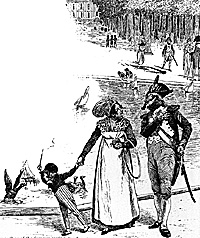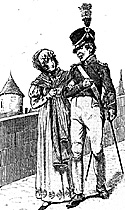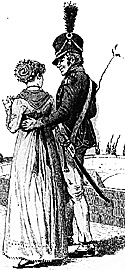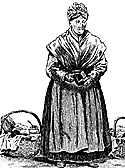
ON MARRIAGE, WOMEN AND SOCIETY IN CONTINENTAL EUROPE
At Historicon 94, I had the opportunity to speak with several readers on generalities in Napoleonic society and especially about the juicy stories I write inLeona's Corner. One thing is sure, the readership wants more of them as well as more recipes of the period.
We have the tendency to judge everything, especially history, by modern standards (or lack of them in certain circumstances). However, to understand society during the Napoleonic period,there are a few basic facts of which we should be aware when we study or speak about the aristocracy, the bourgeoisie andthe peasants living during the Wars of the French Revolution and of the Empire.
One of the facts we should be aware of is that marriage was not what it is today. Even in the lower classes of 18th and 19th Century society, most people did not marry for love. For many, love and marriage were two entirely different matters. Most marriages were arranged for reasons quite removed from the Judeo Christian ideal.
It was especially true in aristocratic society which had always followed the traditions of courtly love. Marriage was apractical institution for the preservation of property and lineage, but poetry and romance were sought outside the bonds of marriage. Prince Metternich, the famous Austrian diplomat wrote, "We marry to have children and not to satisfy the desires of the heart." [1]
That philosophy goes back centuries. It was particularly prevalent among the reigning families of Europe and the nobles where the interests of the state or of the fiefdom (whatever its size) were the primary objective. To sum it up in aphrase, the interests of the dynasty must be protected at all costs. [2]
With that in mind, we should not be surprised to see Henry IV of Frances [3] or Louis XIV having so many mistresses, among whom was the famous Mademoiselle de la Valliere. [4] Or to see the tradition followed by Louis XV with DuBarry, Pompadour and other consorts?The great Catherine of Russia built up a reputation comparable to that of the Kings of France, even sacrificing her husband for the interest of Russia [5] in the process!
Louis XVI [6] broke the tradition and was a model of marital fidelity. In truth, he was interested in little else besides geography, hunting and making locks, no doubt part of the reason for which he lost his head. [7]
We can see a certain similarity between the Great Frederick of Prussia and Napoleon considering their concept of love. Napoleon abhorred the idea of women influencing politics. He blamed, not without reasons, the moral laxity in France on the social freedom of women under the old regime. He declared his personal feeling on the matter when he remarked, rather unromantically, to his Council members, "Love is an exchange of perspirations!" He also considered that such exercise (infutility?) took too much time away from really important things such as making war: "It takes time to make one self loved, and even when I had nothing to do I always vaguely felt that I had no time to waste" [8]
Well, in a future issue, we'll see that the Emperor changed his mind several times after the last statement and took the opportunity to waste his time .. . but, his love affairs did not change his attitude toward women.
Place of Women
We have already seen in EE&L #7 [9] that Napoleon had a specific, provincial concept on the place of women in society that alienated many influential women including Madame de Stael. He was against any emancipation of women and any participation by them in political life. Yet, on one occasion when Madame de Stael was told by Napoleon that it was not fitting for a woman to take an interest in politics, she answered point blank: "In a country where women have been decapitated, it is only natural for other women to ask why?"
That very pertinent remark did not make any impression on Napoleon, who wrote: "What a mad idea to demand equality for women! Nature intended women to be our slaves; only through our stupidity do they try to rule us. They are our property, we are not theirs. They belong to us, just as a tree which bears fruits belong to the gardener." On another occasion he declared: "Women are machines form making babies.";
The latter quotation fits very well with the answer he once gave to Madame de Stael while he was as only a general:
"General, what kind of woman would you like the most?"
But we should digress from our main topic, which is the concept of marriage and women within the reigning families, the aristocracy and the bourgeoisie as well as the peasants, who, as soon as they acquired property, endorsed the preservation of property as much as the other classes. In addition, in spite of a movement for the emancipation of women, let us not forget that women had far less rights and far less to say about their destiny than they do today. Most were married with out being asked.
Social Freedom
Despite that, social freedom for women in France as well as in Central Europe had increased in the 1700's. What did the Revolution do for women? While the French revolutionaries were proclaiming their famous slogan Liberte Egalite et Fraternite, they quietly declined to extend full citizenship to the female sex despite the efforts of women activists like Madame de Stael and Olympe de Gouges in France. The only liberalization achieved was the legalization of divorce.
In France, the Revolution had only eased the legal restrictions that prevented women living as individuals with free choice. Even this small beginning was too much for Napoleon.
As soon as he became First Consul, Napoleon started to put France back on a stable footing by reorganizing government, finances, laws and the judicial system. When he became Emperor, he put an end to the brief period of greater legal and social freedom that women had enjoyed. He bequeathed France with the Code Napoleon, a monumental piece of legislation that became the cornerstone of the French judicial system up to the present. [10] The document had been drawn up by a large staff of judicial experts but the part concerning women had been revised in stricter terms by Napoleon himself. Basically, the Code declared married women the property of their husbands and curtailed their legal and property rights for over a century.
Yet, by the 1700's in the Protestant continental countries, open separation and divorce were increasingly common. Madame deStael, herself a victim of an arranged marriage, [11] wrote: "Marriage in Germany is becoming less an association which has for its result affection than an affection of which the consequence is association."
One cannot stop evolution. The brief revolutionary period had changed the way women behaved and dressed, setting a trend that in addition to Madame de Stael, eventually produced the late social romantic writer Georges Sand. Napoleon may have exiled Madame de Stael, but he could not suppress what was going on in the salons.
Perhaps the most significant change in the attitude of women toward them selves was reflected by their clothing. Gone werehoops, panniers, constricting corsets, powdered wigs of the OldRegime. As seen in EE&L #5, [Madame Recamier, page 24] dresses in the so-called Greek style, often transparent, cut loosely following the line of the body, suddenly provided the aristocratic and bourgeois women with complete freedom of movement and other things unknown to them until then. Now they could walk, stride, run, jump in and out of carriages. Their hair was cut short, etc. The Emperor with all his power was unable to change fashion and in spite of him, the trend toward emancipation was irreversibly set.
I hope the above will shed some light on the behavior of society during the Napoleonic period, like that of Berthier [12] with the Visconti and Elizabeth, and open the door for many more discussions in future articles.
[1] Metternich found it impossible to live without une amie (a mistress), an intimate woman friend.
Louis' remarks on the events of July 14 are quite peculiar considering the Bastille had been taken and Paris was in open rebellion. One day, his son asked him: "Why do the people who love you so much suddenly become angry about you? What have you done to irritate them What he had done? Well, nothing, of course.
Most if not all of Napoleon's Marshals enjoyed the good life and good food while on campaign. [1] The amazing part is that this lifestyle was conducted in the open, in front of the soldiers who sometimes lacked everything. What follows was typical.
In Spain, just prior the French defeat at Vitoria, Marshal Marmont's servants - real theatrical lackeys with long gaiters a l'anglaise short culottes and the rest of the work - prepared a lunch for their master and his staff. Out of cantines carried by a 30-mule train came damask cloths, precious dishes, cold dishes, game, poultry, pates, bottles of Burgundy and Bordeaux. The old soldiers witnessed this deployment of luxury without the slightest surprise or discontent. That appears completely normal for a Marshal of France and sometimes, the marshal did not hesitate to have them profit from the leftovers of his luxurious table.
After all, Napoleon rewarded his marshals handsomely and they were eager to profit from their money to the maximum. Some felt that this campaign may be their last one.
Take a look at what was served to Marmont: game, pates, etc. In EE&L # 8, we saw what the Napoleonic soldier could do with game, especially rabbit and had the pleasure of presenting an excellent recipe for rabbit in a red wine sauce.
What about a recipe for a pate? I know that during these days the age of low-fat diets, cholesterol consciousness, etc. - pates are considered by many to be dietetically passe. What a shame! But one does not have to eat such a pate everyday, and an exception can be made once on a while. The one l am going to give below is absolutely outstanding, if you follow the recipe to the letter without any short cuts. If you don't try it, you'll never know what you are missing and never know the full extent of a Marshal's culinary experience.
Julia Child in her Mastering the Art of French Cooking, [2] p.564, says:
It's what I did with the recipe below.
In principle, the word pate should apply only to meat or fish dishes enclosed in pastry and/or baked in the oven.
Do not expect a top notch pate to be inexpensive as you will see by the ingredients below. The variations are endless and, in addition, may include game, truffles, Madeira, Port and Cognac. [3] When the pates are cooked and served cold in their baking dish, it is called either a terrine or a pate. If it is molded in a pastry crust, it is a pate en croute. A boned chicken, turkey, rabbit, pheasant, duck, etc., with the same type of mixture is called a gallantine. Any of those are great as appetizers or hors d'oeuvres and a magnificent addition to any picnic.
Fresh pork fat is an essential ingredient of pate's. It prevents the pates from being dry and gives them a light texture. The preferred type is fat back.
Pates may be cooked in almost any kind of a baking dish from a special rectangular mold - also called a terrine - to a soufle dish or bread pan, although the best material is a glazed pottery.
The following serves 10 to 12 people, but will keep well over two weeks refrigerated. So you can have it as an appetizer during the holidays and keep the surplus for another day.
Combine the ground meat in a large mixing bowl. In a heavy 8-to 10-inch skillet, melt the 3 tablespoons of butter over moderate heat. When the foam subsides, stir in the shallots and garlic and cook, stirring constantly, for 5 minutes, or until soft but not brown. With a spatula, scrape into the bowl of meat.
In the same skillet, melt 2 tablespoons of butter and cook the liver for 3 to 4 minutes or until it is stiffened but is still pink inside. Remove the liver with a slotted spoon and set it aside on a plate. Pour the Cognac into the skillet and boil it, stirring and scraping in any browned bits that cling to the bottom or sides of the pan, until it has been reduced to about 2 tablespoons. Pour this glaze over the meat and shallots. Set the skillet aside.
Add the cream, lemon juice, flour, egg and allspice. Add salt and a generous grinding of pepper to the meat mixture. Knead vigorously with both hands, then beat with a wooden spoon (or in an electric mixer) until all the ingredients are well blended and the mixture is soft and fluffy. Add more seasoning if needed.
The mixture is ready to be transferred to the terrine (which should be about 2-quart capacity). I completely line the bottom and sides of my terrine lengthwise with bacon strips and then pour the mixture into it, pressing hard with a spatula. Then, I completely cover up the mixture with additional bacon strips and lay the bay leaf on top of the fat. Cover the top with aluminum foil and cover tightly.
Preheat the oven to 350øF.
Place the mold in a large deep rectangular baking pan and place it on the middle shelf of the oven. Pour in enough hot water into the pan to reach at least half way up the side of the mold. Bake for about two hours or until the fat and juices which will have risen to the top are clear yellow.
Remove the terrine from the oven and lift the cover and remove the aluminum foil. Then, and this is very important loosely cover the mold with fresh aluminum foil and weight the terrine by placing a heavy pan, or anything you may see fit, to even the pressure of several pounds over the pate (I use two large cups and place some weights on it - about 4 pounds). During the cooling off, most of the excess fat is expelled from the pate, making it much lighter.
Let cool at room temperature and refrigerate with the weights still on it until it is thoroughly chilled.
To serve, remove the weight and the foil, remove the top layer of fat and cut slices (about 1/2 to 3/4 inch thick) directly from the mold and serve with fresh French bread.
Wines to be served with pates include the dry white wines such as (French) Chablis or Macon (or California Chenin Blanc) and light red wines like a Beaujolais.
As mentioned above, the pate will keep refrigerated for at least two weeks. In addition pates may be frozen, but while still very good, they will never again have their original texture.
Other sources: Larousse Gastronomique, Crown Publishers Inc. New York.
Misc. notes.
Back to Empire, Eagles, & Lions Table of Contents Vol. 2 No. 10 This article appears in MagWeb (Magazine Web) on the Internet World Wide Web.
"Mine."
"That is very simple, but which one is the one that you would like the most?"
"The one that knows best to take care of her home."
"I certainly understand that clearly. But finally, which will before you the first of all women?"
"The one that makes the most children, Madame."

Footnotes
[2] History is full of such instances. Eleonore of Aquitaine, by her subsequent marriage to Henry II of England after Louis VII divorced her, initiated a long struggle between France and England over Aquitaine. Another more contemporary (to our period of interest) example was the betrothal of Archduchess Marie-Louise to Napoleon in the interest of Austria.
[3] He wrote: "Souvent femme vary, bien fol qui s'y fit." (Often a woman changes her mind. The fool is the one that believes her.)
[4] Louise Francoise de la Baume Leblanc de la Valliere (1644-1710), maid of honor to Louis XIV's sister-in-law, Henrietta of England, became the King's mistress in 1661. She bore him four children, of whom two died in infancy. In 1667, by the same government act which legitimized her daughter, she was created a duchess. She was replaced in the King's affections by Madame de Montespan. In 1674, she retired to a Carmelite convent and became celebrated for her piety.
[5] Catherine, daughter of Christian August, prince of Anhalt-Zerbst, became the wife of the future Peter III of Russia. Her successful effort to become completely Russian made her popular with important political elements who opposed her eccentric husband. Peter III became Czar in January 1762, but he immediately alienated powerful groups with his program and personality. In June 1762, a group of conspirators headed by Grigori Orlov, Catherine's lover, proclaimed Catherine autocrat, and shortly afterward Peter was murdered, and Catherine's rule over Russia began.
[6] Married in 1771 to the unfortunate Marie-Antoinette, the Dauphin, the future Louis XVI, had great difficulties in fulfilling his marital duties. The marriage remained unconsummated for seven years.
[7] During the events of July 14, 1789, Louis' journal quoted by Andre Castelot in Drames et tragedies de l'histoire, (Librarie Academique Perrin, Paris, 1966) p.201 reads:
"July 10, 1789: Nothing, answer to the deputation of the States Generals.
July 11: Nothing, departure of Mr. Necker.
July 12: Vespers, departure of MM. de Montmorentin, Saint-Priest and de Luzerne.
July 13: Nothing.
July 14: Nothing.
July 28: The poor weather prevented me from going out.
July 29: Nothing, return of Mr. Necker.
July 31: The rain prevented me from going out."
[8] Was Nalpoleon the author of the famous saying that I heard many times ( jokingly, I hope ) when my - husband was in the French army: "Man is made for war and woman for the diversion of the warrior!"?
[9] See EE&L #7, Napoleon unit Women, Part 1,pp.33-35.
[10] Which is not to say that the Code Napoleon was not a great piece of legislation. It's still in use today in France (as well as in Louisiana in the United States). Over the Years, the Code has been amended to allow women equal status.
[11] Madame de Stael.
[12] See EE&L #4, Marshal Berthier and Napoleon, La Visconti and Elizabeth, pp.16-17, etc.
NAPOLEON'S MARSHALS AND FOOD WHILE ON CAMPAIGN
FOOD AND THE MARSHALS

"The memory of a good French pate can haunt you for years. Fortunately, they are easy to make, and you can even develop your own special pate maison."
LEONA S TERRINE MAISON
1 pound of fresh pork fat, ground
1-1/2 pounds of lean pork, ground
1-1/2 pounds of pork liver4
1/2 pound lean veal, ground
1 package of bacon strips
5 tablespoons of butter
1/2 cup of finely chopped shallots
1/2 teaspoon of finely chopped garlic
1/4 cup of Cognac
tablespoons of heavy cream
2 tablespoons of lemon juice
2 tablespoons of flour
1 egg lightly beaten
1/2 teaspoon of allspice
freshly ground black pepper
1/2 pound fresh pork fat back from pork loin,
sliced into 1/8-inch strips
1 large bay leaf

Footnotes
[1] Of course, there were exceptions such as during the winter Campaign of 1807 in Poland and the retreat from Russia.
[2] Julia Child, Mastering the Art of French Cooking, Alfred A. Knopf, New York, 1961.
[3] For good results, it is very important to use only true original ingredients and not to substitute a California Port or Madeira for their original counterparts. The same is true for Cognac.
[4] Pork liver can be replaced with veal liver. However, the results are not as good. By the way, in the baked pate, the taste of liver is hardly detectable.
Back to EEL List of Issues
Back to MagWeb Master Magazine List
© Copyright 1995 by Emperor's Headquarters
Other military history articles and gaming articles are available at http://www.magweb.com
